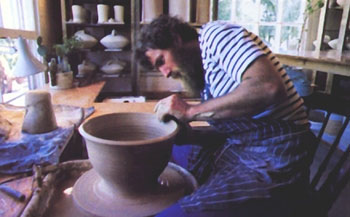Welcome to the studio. This is where Jon makes his pottery. There are many steps to making a single completed piece of pottery:
- The clay is prepared. For the stoneware pottery that Jon makes the clay is a mixture of diferent chemicals and powders as well as natural clay. Jon has two different formulas for his clay; one for thowing, and one for hand built pottery. In the next few steps clay is trimed away from the pieces, to be recycled at this step when the clay is mixed. This is done by combining all the components in a very large and powerful mixer. The mixer that Jon uses we he is recycling his clay is actually a industrial dough mixer.
- The peice is thrown on potter's wheel or hand built. Although this
is the most glamourous part of making pottery it is really just one small
step.

- Right after the peice is thown or hand built, often while it is still wet, a pre-firing glaze is often applied. This glaze is usually covered over with other glazes latter which it will react to when fired.
- When the clay has dried to a leathery state the work is trimed, or additional parts are added to it such as handles or spouts. (Speaking of which teapots are actually two seperate peices of pottery, the pot itself and the lid, and each part has to be made seperately.)
- Once the clay is sufficently dry it is fired for the first time in what is called a "bisque firing". This first firing is done in Jon's propane kiln. Although this firing is not as hot as the second firing (the glaze firing) it is still hot enough to heat the fire bricks of the kiln untill they glow. A firing is a long process, first the kilm is loaded so that the peices are not touching (if they were they would stick together) this takes two to three hours. Then the kiln is fired for about eight hours, during which time the burners must be adjusted to keep the temperature just right. When the firing is done it takes at least another eight hours for the kiln to cool down enough to be unpacked, and even then protective gloves and clothing must be worn.
- After the bisque firing the pots are decoratively glazed. Glaze is actually silicon based with other chemicals added for colors.
- Once the pottery is dry from the glazing it is fired in the kiln again, in what is called a glaze firing. It is called this because this is where the glaze is fused to the pottery. The silicon based glaze and the clay are heat to such a high temperature that they fuse together, and the glaze actually becomes a glass coating. As well you may have noticed that Jon's pottery has spots on it. This is because during the glaze firing the iron minerals that are in the clay are heated so much that they oxidize and move to the surface mixing with the glaze. The glaze firing takes longer that the bisque firing, and thus must be given a longer time to cool down before it can be unpacked.
- As Jon unpacks his kiln he will grind each pot. What this means is he will take a special type of stone and grind by hand areas where bare clay had contact with the shelves of his kiln. This is necessary to take of any sharp edges that from the bottoms of the pots.
- After this the pots are ready to be cleaned and put into the showroom, unless they are certain tea pots, paintings, or murals. In which case they must be mounted and framed, or no clay handles must be attached.
